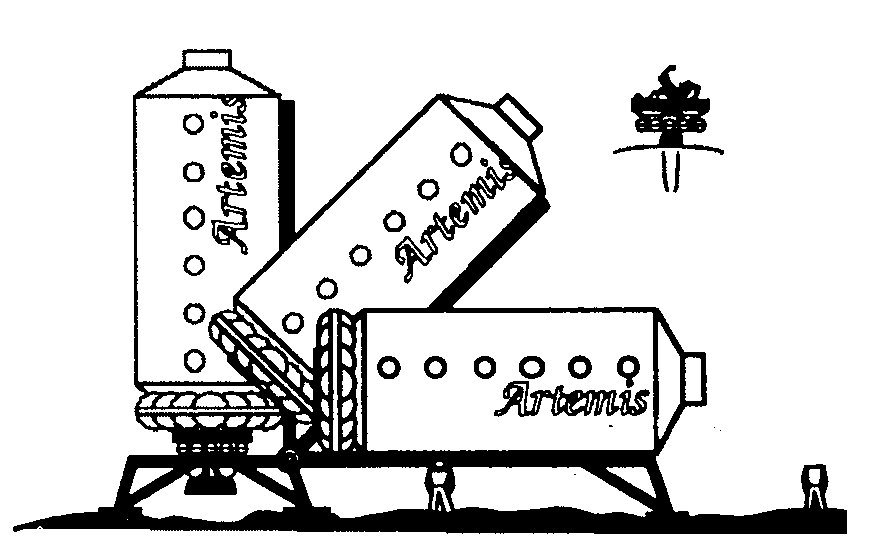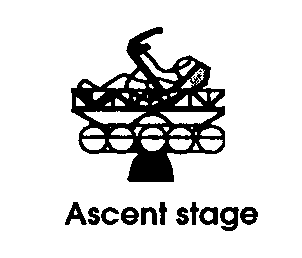
Prometheus
Newsletter of the LFS

The Artemis Project is a privately financed commercial venture to establish a permanent surface lunar base and to exploit the resources of the moon for future development of space travel. The first Artemis flight places a habitat on the moon for permanent occupation.
The goals of the project are to build a permanent manned base on the moon, to exploit lunar resources for profit, to demonstrate that manned space flight is within the reach of private enterprise, and to bootstrap private industry into manned space flight. Artemis is unique among proposals for developing a moon base because it is a 100 percent privately financed commercial venture which will place the first element of the lunar base on the moon within the next decade, and because it will show a profit from the first flight to the moon.
The project is sponsored by the Lunar Resources Company.
Previous moon base studies have based their cost models on the performance of government projects, and assumed revenues would come only after decades of development. The resulting high capital costs and long term before realizing any profit made it impossible for private enterprise to finance a manned space venture; but by using standard commercial business practices, costs can be reduced to less than 10 percent of a similar government-sponsored program. Additionally, Artemis reduces its costs by using technology and resources already developed in previous manned space flight programs.
Our current estimate for the cost of the first flight is about $1.3 billion. About two-thirds of the money is spent on launch to low earth orbit. This level of investment is quite common in the busines world. For example, one new deep-water oil rig typically costs about one billion dollars.

Artemis will pay for its initial development by exploiting the entertainment value of its first flights. We estimate the market value of the first flight from all sources to be just over $1.5 billion.
This is why the first mission must be manned; the entertainment value of a robotic flight is not sufficient to pay the bills. The estimated revenues are based on comparison to similar mass-marketing ventures which tie movies or television shows in with associated products. The Apollo program was run with engineering precision, its drama hidden by the need for a government agency to present an unflagging image of confidence to the world. In contrast, the Artemis Project is designed to be entertaining from the start. With half a dozen science fiction writers already working on the project, we should be able to attain that goal and still retain the appeal which sets the project apart from science fiction productions—the Artemis Project is real.
In short, we plan to pay for the initial stages of the project through shameless commercialism.
The reference mission is being used in the current feasibility study to determine costs, revenues and technical and logistical issues. Two Space Shuttle launches place the Artemis hardware into low Earth orbit, where the moon vehicle is assembled. Our crew goes up on the second Shuttle flight.
The space mission is used as a staging base in the reference mission. If it is not available, we launch the first element on one flight and then rendezvous with it on the second flight. In that case our crew uses the Shuttle as a staging base for assembling the Artemis spacecraft.
The lunar transfer vehicle (LTV) is a small spaceborne habitat with propulsion systems and support for the crew during flight between Earth and lunar orbits. Its rockets are used to fly to lunar orbit. The reference mission uses a trajectory almost identical to the Apollo flights.
Upon arrival in lunar orbit, the lunar base core module with its descent rockets separates from the lunar transfer vehicle and lands on the surface of the moon using a propulsion package attached to the core module's pressurized habitat. The lunar transfer vehicle remains unmanned, in lunar orbit while the crew descends to the surface.
On the moon, the crew levels the lunar base habitat and reconfigures the lunar base for permanent operation.
The crew conducts extravehicular activity to assay the site and gather samples of the lunar regolith (moon dirt). They film activities throughout the flight, both stock footage and scripted scenes for later sale to movies and documentaries.
When surface activities are complete, the crew boards the ascent stage and makes the two-hour flight to rendezvous with the orbiting lunar transfer vehicle. The ascent stage is a simple open vehicle, so crew members depend on their space suits for life support. Except for not being able to quickly return to base in an emergency, the hazards to the crew during the ascent are no greater than two hours outside on the moon's surface.
After docking the ascent stage to the LTV, the crew returns to Earth, where they use their rockets to enter Earth orbit for a rendezvous with the space station.
They leave their transportation system in orbit for use on later flights to lower the cost of future development. The lunar transfer vehicle may be used at the space station for additional laboratory space between flights, or it may be leased for other operations in Earth orbit. After the Artemis vehicles have been secured at the space station the crew returns to Earth on the next available Shuttle flight.
Once the crew goes home, a telebot is used to bury the core module in moon dirt for thermal insulation as well as protection from radiation and meteoroids. The robot also may be able to get camera footage of the Artemis stack's initial descent to the lunar surface. This will be the first time any vehicle has been recorded landing on the moon.
Early in the project, we decided to go back to the tradition of using names from ancient mythology for manned space flight programs. Mercury, Gemini, and Apollo carried human beings to the moon in less than ten years, but manned space flight programs lost sight of their exploratory nature and fell into lethargic bureaucracy when they adopted more pedestrian names like Skylab, the Space Shuttle, and the Space Station.

Artemis is a twin sister of Apollo in Greek mythology. She is the moon and Apollo is the sun. Artemis is also the goddess of the hunt, a constant reminder that our project is a voyage of exploration, a venture which will live off the land in its travels and return products of great value to our home on Earth.
We are conducting a feasibility study to examine technical, political, and financial issues in more detail. So far, the more detail we dig up the better the cost picture looks and the worse the political picture looks.
The first flight could launch as early as the year 2002. Please keep in mind that a key cost-saving factor in Artemis is to work no faster than the current need and available resources; this is a working schedule, not a worshipped schedule.
An article about the project will appear in the January issue of Analog magazine.
The Artemis Society is an organization formed to support the project with volunteer, research and financial aid. Basic Artemis Team membership is $25 per year. Members receive our newsletter Pleiades, among other benefits.

Investment opportunities will be available in 1995. We are planning to raise most of the capital for the project through the sale of stock in a series of public offerings. Write to us at the post office box if you would like to receive notice of the initial public offering.
Research and organizational support are needed to carry out the feasibility study. There are hundreds of things that need to be done to get this project going, some of which are bound to match your interests and talents. Write to us, or join the on-line discussion.
Artemis Magazine is scheduled for publication in 1995. We are accepting submissions of articles and art for the publication now, and will consider fiction related to the Artemis Project or development of a human presence on the moon in general. Send an SASE for guidelines.
On-line communication: The main public forum for the project is on GEnie, page 470, category 28. Our email address is artemis@LunarCity.com. To join our electronic mailing list, send email to server@LunarCity.com with the body of your message being: join artemis-list.
© 1994 Lunar Resources. The Artemis Project is a service mark of the Lunar Resources Company. This paper may be freely distributed as long as copyright and service mark notices are intact. The Artemis Project, P.O. Box 590213, Houston, TX 77259-0213.
|
All trademarks and copyrights property of their owners. |